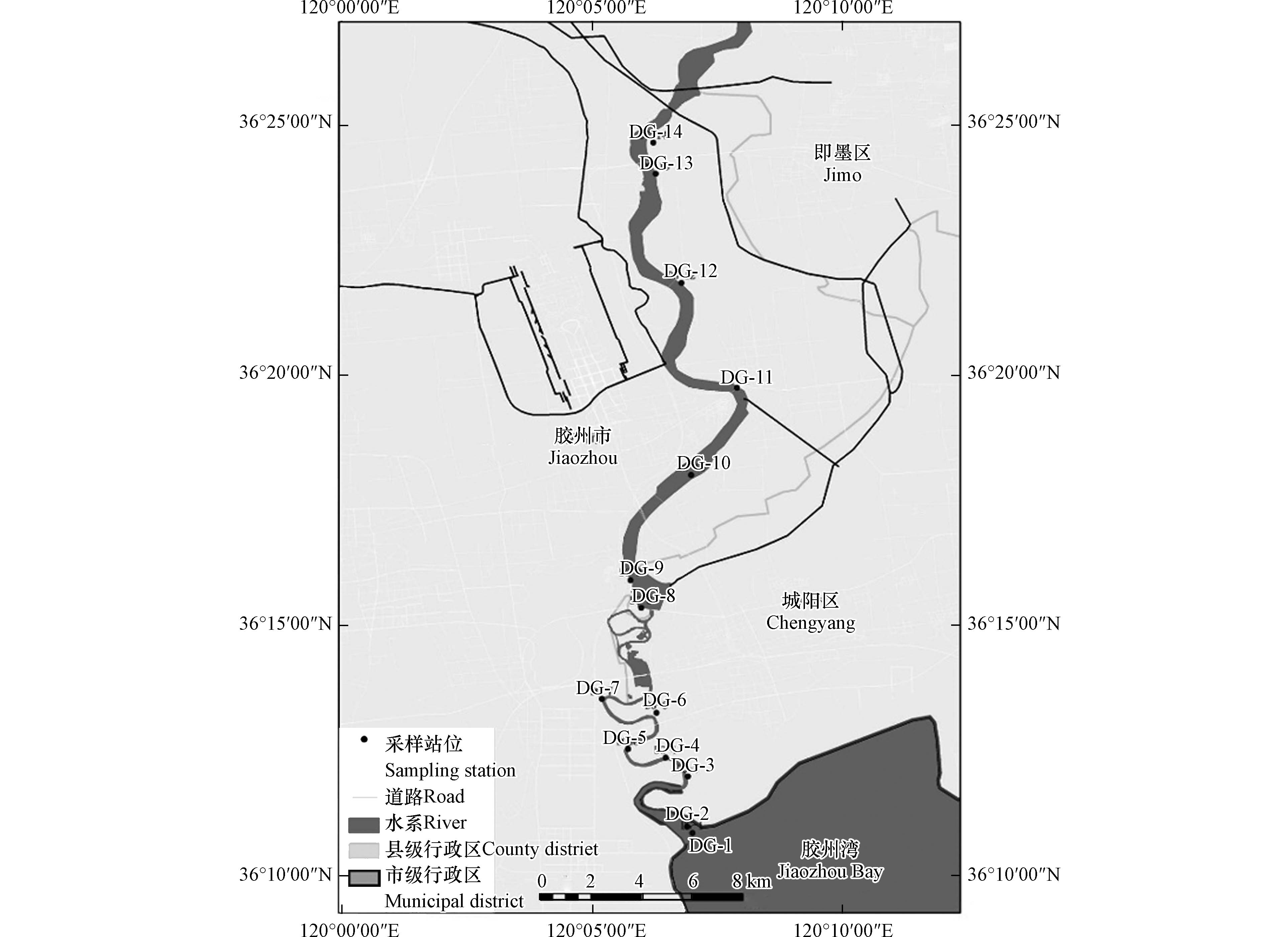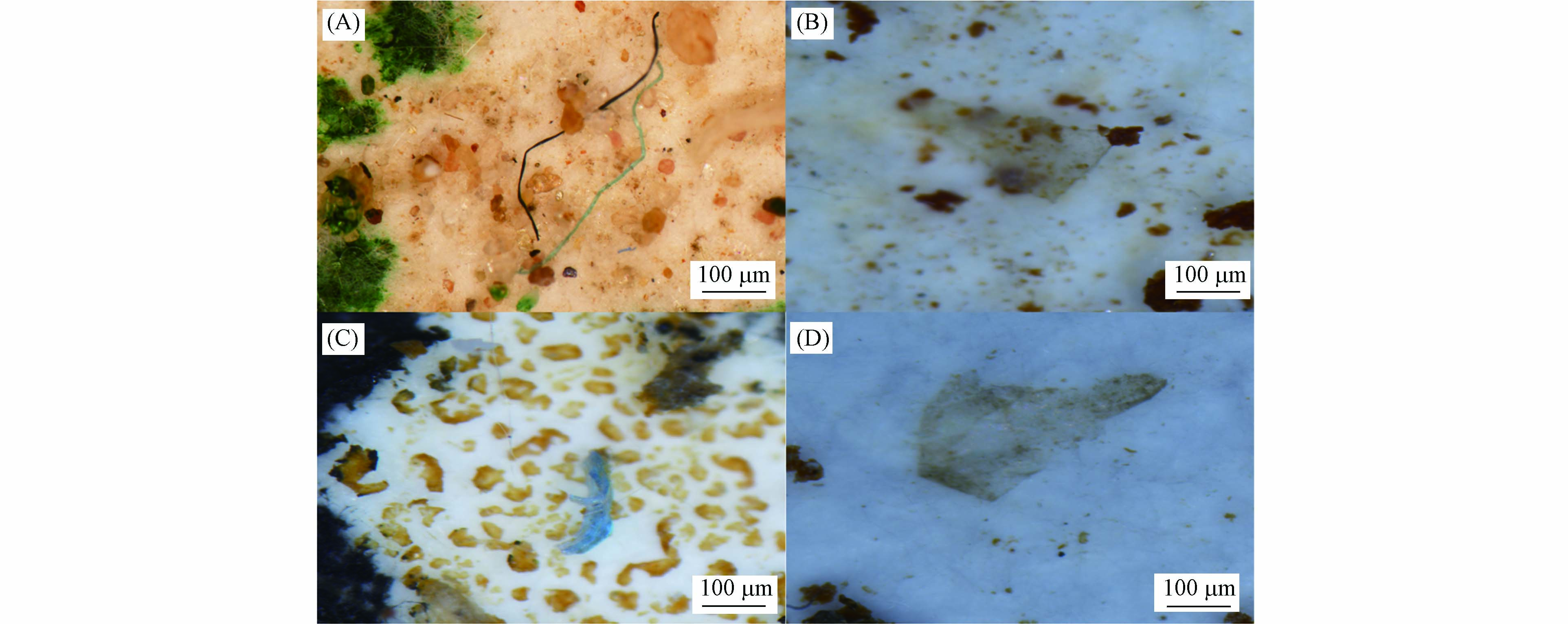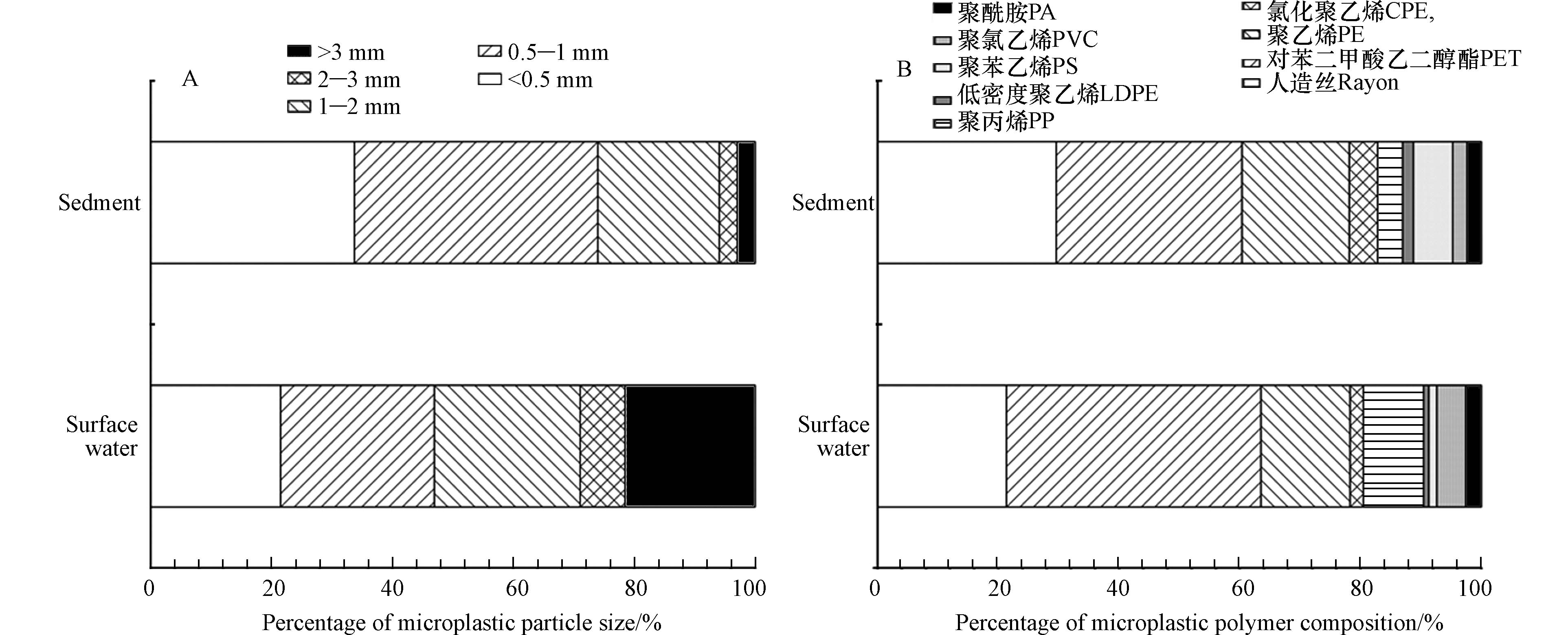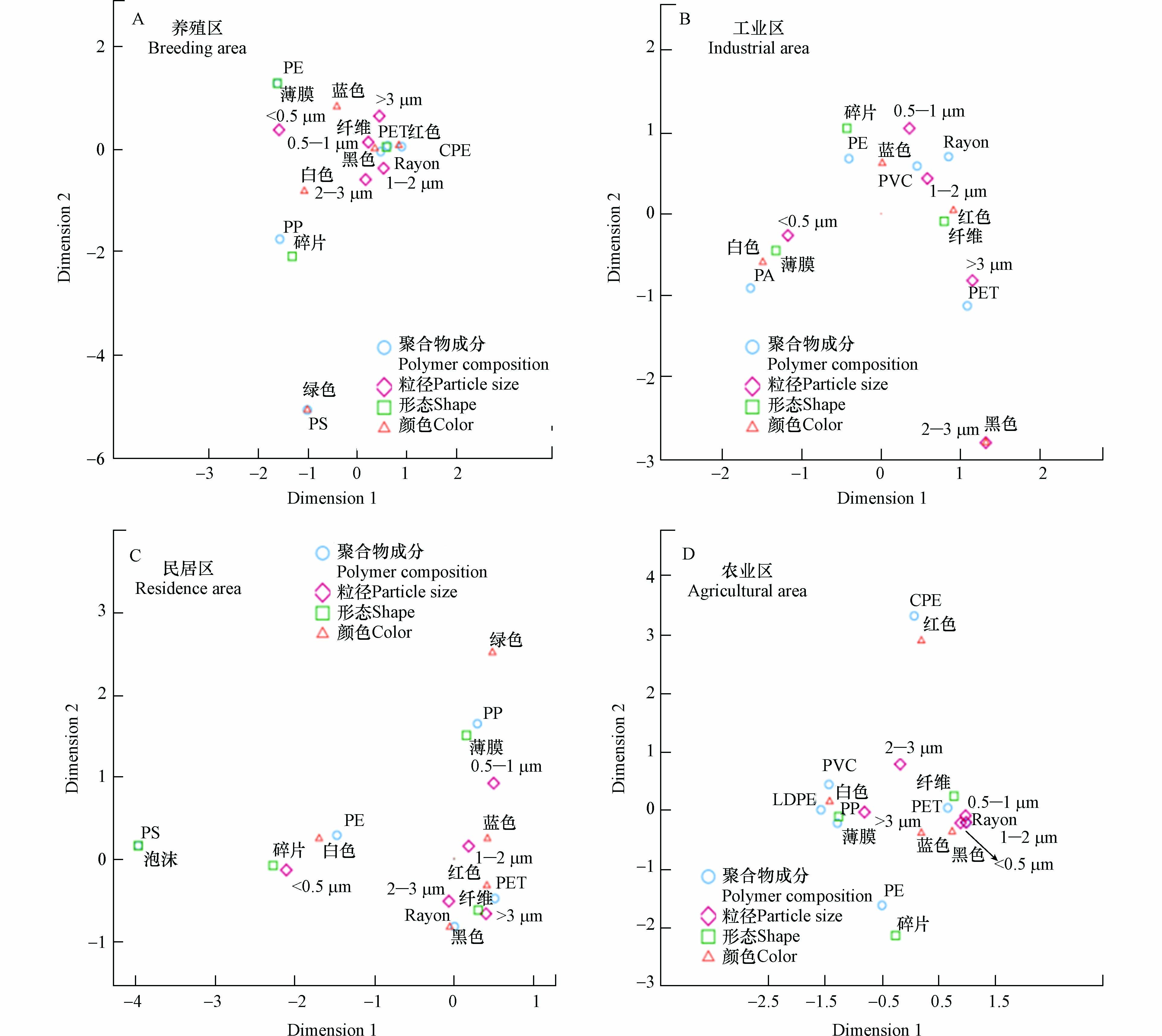-
塑料由于其轻便适用等优点,已成为人类日常生活不可或缺的一部分. 随着塑料大规模的使用,其产生的废弃塑料给环境带来了很大的压力[1]. 塑料经过风化或化学降解等作用会碎裂成粒径更小的塑料颗粒[2],当其粒径<5 mm时,即被称为微塑料(microplastics, MPs)[3]. 微塑料具有粒径小和比表面积大等特点[4],许多重金属和抗生素极易吸附在其表面[5-6],给环境带来的危害更大.
为了全面评估微塑料给环境带来的生态风险,需要表征其丰度,特征及潜在来源[4]. 科学家首先在大洋中发现微塑料的踪迹[7-8],随后在近海区域也发现了微塑料的存在,Zheng等[9]调查了胶州湾表层水中微塑料,其丰度为20—120 items·m−3,发现海湾中微塑料聚合物类型与河口的微塑料聚合物类型非常匹配,认为河流输入是海湾微塑料的重要贡献者. Zheng等[10]调查了胶州湾沉积物中微塑料,其丰度为2.5—27.5 items·kg−1,进一步发现微塑料丰度在深层沉积物中非常低,并且通常从地表向下呈下降趋势. 近年来研究发现淡水环境中的微塑料污染甚至比海水中的微塑料污染更加严重[11], Lin等[12]研究发现广州沿珠江地区表层水和沉积物微塑料丰度范围分别是379—7924 items·L−1和80—9597 items·kg−1,表层水中微塑料丰度最高是在支流的汇合处,而沉积物中微塑料丰度最高点位于上游,说明微塑料丰度会受到地形,人类活动等因素影响. Ding等[4]调查了渭河表层水和沉积物中的微塑料,其丰度分别为3.7—10.7 items·L−1和360—1320 items·kg−1,并进一步发现低水流和高含砂率会导致微塑料的积累和分布. 近年来国内对于微塑料的淡水研究集中在珠江[12]和渭河[4]等大型河流,大型河流支流较多,在进行微塑料来源探究时较困难. 而目前国内对于中小型河流研究较少,小型河流污染源单一,并且流经城市的中小型河流的沉积物可能是微塑料的初始汇,对其进行研究可以探究微塑料的来源,并可进一步了解城市中塑料污染状况.
大沽河位于胶东半岛,是青岛最大的河流,近年来受垃圾污染和污水排放等因素影响,河流水质退化,陆海生态连通性消失等问题接连出现. 本文以大沽河为例,在流域内不同功能区进行采样,探究其表层水和沉积物中微塑料的污染特征以及微塑料在相邻介质间的迁移,建立微塑料变量相关性模型,探寻微塑料各变量在相关功能区中可能的相关性,进一步分析各功能区中最常出现的微塑料,进而溯源塑料垃圾,为中小型河流微塑料分布特征及污染现状提供数据支持,并为大沽河流域生态环境治理提供了参考.
-
大沽河在青岛市内干流长157 km,流域面积4781 km2,大沽河流域功能区复杂,不仅有养殖区、工业区、农业区、还有居民区和风景区. 流域地形复杂,北部多为山区,南部多为平原. 大沽河水源地是青岛市主要供水源之一,但由于近些年来水源开采以及人为污染,生态环境受到严重威胁.
-
于2021年6月,在大沽河的胶州市和城阳区流域内的不同功能区设置14个采样点,分别为:大沽河流域靠近河口的渔业养殖区域设置4个采样点(DG-1、DG-2、DG-3和DG-4),居民小区和小学附近设置3个采样点(DG-5、DG-6和DG-7),大沽河生态旅游区设置2个采样点(DG-8和DG-9共2个采样点),靠近工厂企业的工业区设置2个采样点(DG-10和DG-11),靠近胶东国际机场的农业区域设置3个采样点(DG-12、DG-13和DG-14),具体采样点分布见图1.
-
大沽河流水面积狭窄,因此本研究使用直接采样法。(不锈钢桶)采集区域内表层水10 L,采集的水样经过32 μm不锈钢筛网过滤,随后立刻用超纯水(Milli-Q 超纯水器制备,Millipore SA. 67120,Millipore 公司,法国)将筛网上的残留物冲洗至500 mL棕色玻璃瓶中,低温运回实验室待进一步处理.
-
使用不锈钢铲铲取采样区内的表层沉积物(0—10 cm深度),现场去除每次钢铲掘动时挂联的植物残渣和各种有机碎屑,铲取约1 kg湿重的沉积物,用干净的铝箔纸包裹,低温运回实验室待分析.
-
样品加入30%的过氧化氢溶液,置于50 ℃恒温水浴锅中消解24 h,除去有机质. 使用0.45 μm的玻璃纤维滤膜过滤,过滤后将滤膜置于玻璃培养皿中,50 ℃下烘干,4 ℃密封保存以备后续检测.
-
本研究用分析天平准确称取干燥后的沉积物样品50.00 g,置于洁净的500 mL玻璃烧杯中,向烧杯中加入20 mL浓度为51 g·L−1六偏磷酸钠溶液和200 mL浓度为1.6 g·L−1饱和氯化锌溶液后,在超声仪(SK250H, KUDOS 公司,德国)中超声20 min. 超声后,磁力搅拌器搅拌沉积样品20 min,静置2 h. 重复3次以提高密度浮选效率. 浮选完毕后,上清液通过70 μm的筛网过滤. 用超纯水冲洗筛网上的样品至烧杯中,加入30%过氧化氢溶液,在50℃恒温水浴锅中消解24 h,以除去有机质. 使用0.45 μm的玻璃纤维滤膜过滤,过滤后将滤膜置于玻璃培养皿中,50℃下烘干,烘干完毕后于4℃密封保存.
-
通过体式显微镜(SZX16,奥利巴斯,日本)目检观察滤膜上的微塑料,记录微塑料和疑似微塑料的数量、粒径大小、形状和颜色. 在微塑料数量较多的滤膜上,均匀分成几等份,随机挑选一份进行观察. 利用傅里叶变换显微红外光谱仪(μ-FT-IR,PerkinElmerSpotlight400,铂金埃尔默公司,德国)对微塑料聚合物成分进行鉴定.
-
为保证采样和实验过程未受到污染,全程佩戴丁晴手套并穿棉质实验服,对于可能受到污染的器械,使用前用超纯水进行多次清洗. 实验过程中,使用空白滤膜进行对照以排除空气和过滤中使用的液体对实验结果造成的偏差. 对照组中微塑料数目为0,说明实验过程中未受到污染.
-
本文将多重对应分析技术[13](MCA)引入微塑料的研究中,去探究多个分类变量之间的关联性. 根据数据本身的关联,将微塑料的颜色、粒径、形状和聚合物成分转化为相应的分值,并在转化时将变量间的关联转化为线性,建立类别点的联合图模型,从而实现探究多个变量之间的关联. 在对表层水和沉积物4个功能区进行分析时,相关性模型的Cronbach系数都>0.7,表明该量表有相当的信度. MCA维度一和二的惯量很好,表明该模型是可以接受的.
-
使用ArcGis10.2软件绘制采样点位分布图;使用SPSS22.0进行斯皮尔曼相关性分析,所有结果数据均在显著性水平为0.05情况下检验;相关图表使用Origin2018和Excel2019完成. 本研究水体中微塑料丰度单位使用“items·L−1”表示,沉积物中微塑料丰度单位使用“items·kg−1”表示
-
大沽河表层水体和沉积物各点位微塑料丰度分布情况见图2. 大沽河14个站位都检测到微塑料,大沽河表层水中微塑料的丰度范围为0.6—3.8 items·L−1,平均丰度(2.0±0.9)items·L−1. 为了解大沽河水体中微塑料的污染程度,和其他地区淡水中微塑料的污染程度进行了比较,研究区表层水中微塑料浓度远低于中国三峡(1.6—12.6 items·L−1)[14]和美国加勒廷河(0—67.5 items·L−1)[15],但明显高于中国北江河((0.6±0.5)items·L−1)[16],与中国武汉城市地表水(1.7—8.9 items·L−1)[17]微塑料污染程度相当. 本研究从DG-1—DG-14站位微塑料丰度情况来看,整体呈下降趋势. 在空间尺度上渔业养殖区DG-1站位微塑料的丰度最高,为(3.8±0.8)items·L−1. 农业区的3个站位微塑料丰度相差过大,DG-12站位相比农业区的其它两个站位偏高的原因可能是因为胶东国际机场位于附近,车辆行驶[18]以及大气沉积[19]都有可能是微塑料的潜在来源. 此外本研究发现随着河流从农业区流向下游工业区,微塑料丰度有逐渐增加的趋势。与农业区域相比,工业区域涉塑涉水等工业活动增多,可能会影响MPs丰度分布[20];也有可能是MPs顺着河流纵向迁移,逐步累积,导致其丰度增加。实地走访发现,大沽河近年来修建多处拦河坝,其主要目的是积蓄河水,拦水坝的存在会改变前段和后段水体流速,影响微塑料在水体和沉积物中的悬浮、沉积和再悬浮,引起不同区域MPs丰度发生改变。
大沽河沉积物中微塑料的丰度为60—480 items·kg−1,平均丰度为(240±110)items·kg−1. 研究区低于中国西北部渭河(360—1320 items·kg−1)[4]和巴西亚马逊河(417—8178 items·kg−1)[21],与已报道的澳大利亚布里斯班河(10—520 items·kg−1)[22]污染水平相当. 在渔业养殖区中DG-1站位丰度为400 items·kg−1,远高于平均丰度(240±110)items·kg−1,可能是河口沉积物的冲淤造成了微塑料的积聚[23]. 农业区的DG-14站位丰度仅为(60 ±2)items·kg−1,明显低于DG-13站位MPs丰度,可能是人为活动干扰较少所致[20],而DG-13站位处于新建拦水坝的上游,该处水体流速较低,容易发生MPs在沉积物中的累积. 对大沽河表层水和沉积物中微塑料丰度进行斯皮尔曼相关性分析,结果表明大沽河表层水和沉积物中微塑料丰度并无相关性(P=0.151>0.05), 说明人类活动[20]会对大沽河流域不同介质中微塑料迁移产生影响.
-
大沽河表层水和沉积物中检测到不同颜色的微塑料. 如图3所示,表层水中微塑料共有黑色、蓝色、红色、白色和绿色的5种颜色. 蓝色占比最多,为38.60%,黑色次之,为31.14%,绿色最少仅有1.32%. 沉积物中微塑料颜色包括黑色、蓝色、红色、绿色、白色和透明等6种颜色. 黑色占比最多,高达47.93%,红色次之,有23.67%,绿色最少,仅为1.78%. 颜色是推测微塑料来源的重要特征之一[24],有研究表明微塑料可能因表面吸附污染物[25],在物理或者化学作用下造成颜色的改变. 大沽河站位深色微塑料的比例可以从侧面反映出人类活动的程度[26]. 此外,沉积物中微塑料的颜色更丰富,表明大沽河流域微塑料更易发生从表层水到沉积物的纵向迁移.
根据体式显微镜的观察,按照微塑料的形貌特征,将大沽河表层水和沉积物中微塑料的形状分为纤维、薄膜、颗粒、碎片和泡沫. 大沽河流域典型的微塑料形态如图4所示,纤维状MPs粒径从几百微米至几千微米不等,形状细长;薄膜状MPs呈厚度均匀大小轻薄的片状;碎片状表面棱角分明. 大沽河流域各站位微塑料的形态占比如图5所示,在已检出的5种形态中,纤维状在表层水和沉积物中占比最高,分别占比69.57%和62.57%,薄膜状在沉积物中分布的比例为23.39%,略高于表层水体的21.30%. 碎片状在沉积物中分布为10.53%, 在表层水中为8.26%. 颗粒状微塑料仅在河口位置发现,可能是水体中微塑料在流向胶州湾的过程中,部分沉积在河口沉积物中,另一部分汇聚到胶州湾中. 泡沫状微塑料仅在居民区采样点发现,这可能是附近居民由于钓鱼等娱乐活动产生. 纤维状微塑料在所有采样站位发现,纤维的主要成分是人造丝和聚对苯二甲酸乙二醇酯,是日常生活经常可见的塑料纤维. 薄膜状和碎片状微塑料在大沽河流域也很常见,随着功能区域发生变化,其颜色和聚合物成分也会有不同. 此外,体式显微镜观察发现,下游MPs形状更加不规则,可能是在运输过程中发生了老化破碎。
本研究将大沽河表层水体和沉积物中微塑料的粒径分为五类:<0.5 mm、0.5—1 mm、1—2 mm、2—3 mm和>3 mm. 如图6(A)所示,在表层水体中粒径>3 mm的微塑料占比最高,为28.95%,其次是0.5—1 mm的微塑料,占比为25.44%,2—3 mm的微塑料占比最小,仅为7.46%. 值得注意的是大粒径的微塑料在大沽河表层水中占比最多,且大多是以纤维形态出现,可能是在衣物洗涤和生活污水排放过程中产生的[27]. 沉积物中粒径范围在0.5—1 mm的微塑料占比最高,为40.48%,粒径范围<0.5 mm的微塑料次之,为33.73%,粒径范围>3 mm的微塑料仅占2.96%. 值得注意的是在沉积物中微塑料所占比例随着粒径增大而降低,Xiong等[28]也发现了类似的研究规律. 沉积物中大粒径微塑料较少的原因可能是由于光氧化或紫外照射[29]导致表层水中大粒径微塑料降解成小粒径的微塑料,在流动过程中沉积到沉积物中.
使用傅里叶变换显微红外光谱仪对样品进行检测,大沽河表层水和沉积物中共发现9种微塑料聚合物类型. 如图6(B)所示大沽河流域微塑料主要材质是人造丝、聚对苯二甲酸乙二醇酯和聚乙烯. 表层水中微塑料聚合物类型包括聚对苯二甲酸乙二醇酯(PET, 42.17%)、人造丝(Rayon, 21.30%)、聚乙烯(PE, 14.78%)、聚丙烯(PP, 10.00%)、聚氯乙烯(PVC, 4.78%)、聚酰胺(PA, 2.61%)、氯化聚乙烯(CPE, 2.17%)、聚苯乙烯(PS, 1.3%)、低密度聚乙烯(LDPE, 0.87%). 沉积物中微塑料聚合物类型包括Rayon(29.59%)、PET(30.77%)、PE(17.75%)、PS(6.51%)、PP(4.14%)、CPE(4.73%)、PA(2.37%)、PVC(2.37%)、LDPE(1.78%). 在表层水和沉积物中检测到微塑料聚合物组成相同,这可能与两种不同介质的相互作用有关,即微塑料会在表层水和沉积物之间发生迁移. 研究发现,Rayon在表层水中的含量高于沉积物,但PET的含量在沉积物中高于表层水,分析原因可能是由于微塑料自身特征(密度、粒径和形状)的影响,也可能是由于降雨等因素导致微塑料在陆地和表层水中发生迁移[30]. Rayon和PET发现于所有站位,经常是由衣物洗涤产生. 同时PET、PE和PP在日常生活中也常见于塑料膜、泡沫饭盒、饮料瓶及电子包装外壳[31].
-
结合大沽河流域各站位微塑料的丰度数据,表层水中微塑料的丰度从上游至下游整体上呈上升趋势,这一现象很可能是由表层水中微塑料顺着河流方向纵向的迁移所致[30],农业区中,DG-12站位表层水中微塑料丰度(3.0 items·L−1)相比其它站位偏高,原因可能是胶东国际机场位于附近,导致该站位表层水中微塑料丰度较高. 位于DG-11站位表层水中微塑料丰度(3.0 items·L−1)过高的原因可能是该站位位于工业区,由于工业污水的排放导致该站位表层水中微塑料丰度偏高. 根据大沽河微塑料的污染特征,大沽河流域沉积物中检出微塑料颜色数量高于表层水中检出的颜色数量,表明微塑料在表层水和沉积物中发生了相互迁移. 而纤维状微塑料和薄膜状微塑料在表层水和沉积物中分布不一致,一方面可能是由于密度等因素,微塑料本身会发生沉降,另一方面可能是由于水动力扰动作用[32],将沉积泥沙中的颗粒态物质向水中释放. 相同的聚合物成分在表层水和沉积物中分布不一致,可能是受到地表径流、雨水冲刷和大气沉降等因素影响,因此大沽河流域可能还存在陆地到表层水以及大气到表层水之间的迁移.
-
大沽河表层水中各功能区微塑料相关性模型如图7所示(图中A代表养殖区,B代表工业区,C代表居民区,D代表农业区). 值得注意的是在养殖区中碎片、白色和PP有很好的相关性,这种相关性表明养殖区中的白色PP碎片很有可能是来自水产养殖过程中杀菌剂和杀毒剂外包装. 而粒径<0.5 mm、薄膜、蓝色和PE有很好的相关性,表明生活和渔业养殖中的塑料袋有可能是PE薄膜的来源. 在居民区中粒径<0.5 mm、碎片、白色和PE和有很好的相关性,小粒径的白色PE碎片很可能是由附近居民废弃日用品产生的. 粒径0.5—1 mm、薄膜、蓝色和PP有很好的相关性,由于PP塑料的无毒无味和耐高温,生活中的食品包装袋大量的使用可能是蓝色PP薄膜产生的来源[33]. 工业区中粒径<0.5 mm、白色、薄膜和PA有很好的相关性. PA塑料性能较好,在工业上应用广泛,小粒径的PA微塑料可能是由于汽车配件以及防护用品制造和使用过程中产生. 而PE、碎片、蓝色和粒径0.5—1 mm相关性很好. 蓝色PE微塑料碎片可能是由管道和容器制品的生产所致[31]. 更值得关注的是农业区中白色、薄膜、PP、LDPE和PVC有很好的相关性. 这种相关性表明不同聚合物的白色薄膜可能是由塑料袋,农用地膜的使用产生的[20].
-
大沽河沉积物中各功能区微塑料相关性模型如图8所示(图中A代表养殖区,B代表工业区,C代表居民区,D代表农业区). 值得关注的是在养殖区的沉积物中,粒径<0.5 mm、PE、碎片和白色有很好的相关性,尽管和表层水中碎片状微塑料聚合物的成分有所不同,但渔业养殖过程中使用的外包装仍有可能是PE塑料的来源. 而粒径<0.5 mm、黑色、薄膜、PE、PP和粒径0.5—1 mm的相关性较好,这种相关性表明PE薄膜和PP薄膜有可能来自渔业用具外包装和食品包装袋. 有意思的是在居民区中粒径<0.5 mm、PE、PP、蓝色和薄膜相关性也较好,这种相关性表明居民区和渔业养殖区中PE和PP薄膜极有可能是来自居民生活所用的外包装. 值得注意的是工业区中粒径0.5—1 mm、白色、薄膜和PA相关性很好,而PE、碎片和<0.5 mm有较好的相关性,通过实地走访发现大沽河工业区流域水势平缓,可能会导致微塑料在从表层水到沉积物中的沉积速度变快,因此得到和表层水中工业区相同的结果. 在农业区中白色、薄膜、PE、LDPE和PVC有相关性,和表层水农业区中的结果类似,表明农用地膜和日常生活中使用的塑料袋极有可能是农业区薄膜状微塑料的来源,但胶东国际机场紧邻农业区,其复杂的人流汇聚也可能是农业区微塑料的来源. 在表层水和沉积物的渔业养殖区、居民区、工业区和农业区中,纤维是最常见的形状,常常和Rayon、PET以及深色(黑色、蓝色和红色)的微塑料相关性较好,结果表明纤维状微塑料可能是由洗衣过程的生活污水排放产生的,也可能是由于附近人群密集导致衣物纤维脱落,大气沉降所致。
上述相关性模型分析表明,无论水体还是沉积物,不同功能区微塑料的来源存在差别,而同一区域水体和沉积物中微塑料来源类似,整体上具有受本地输入影响的明显特征. 大沽河水环境中MPs 主要来源于养殖产品外包装、居民生活废弃物、电子外壳、农膜和生活污水. 该研究结果为政府对大沽河生态环境治理和城市塑料垃圾监管提供了重要参考:当地塑料污染主要受控于本地输入,受水动力输运来自其他区域的输入影响较小.
-
(1)大沽河流域表层水中微塑料的丰度范围为0.6—3.8 items·L−1,沉积物中微塑料丰度范围为60—480 items·kg−1. 大沽河流域微塑料主要形状为纤维类,颜色以黑色、蓝色和红色为主. 大粒径微塑料在表层水中占比最多,而小粒径微塑料在沉积物中占比最多.
(2)大沽河流域表层水中存在微塑料的纵向迁移. 受到微塑料自身因素和外界因素影响,在表层水和沉积物中存在微塑料的相互迁移,更多的是微塑料从表层水向沉积物的迁移. 表明沉积物是城市微塑料的初始汇.
(3)相关性模型分析表明,无论水体还是沉积物,不同功能区微塑料的来源存在差异,而同一区域水体和沉积物中微塑料来源类似,具有受本地输入影响的明显特征. 该研究结果为政府对河流流域生态环境治理和城市塑料垃圾监管提供了重要参考:当地塑料污染主要受控于本地输入,受水动力输运来自其他区域的输入影响较小.
大沽河流域微塑料在不同介质中的空间分布及其潜在来源探究
Spatial distribution and potential sources of microplastics in different media of Dagu River basin
-
摘要: 微塑料作为一种新型污染物已对环境健康构成了严重威胁. 为调查微塑料在城市河流不同介质中的污染特征及其迁移规律,并基于城市中不同功能区的划分探究微塑料的潜在来源,以青岛大沽河为例,在2020年6月对表层水和沉积物进行取样分析. 结果表明,大沽河表层水和沉积物中微塑料丰度 分别为0.6—3.8 items·L−1和60—480 items·kg−1,表层水体中大粒径微塑料(>3 mm)占比最多,为28.95%,而沉积物中小粒径微塑料(0.5—1 mm)占比最多,为40.48%;大沽河微塑料颜色以深色系为主(黑色、蓝色和红色),形状主要是纤维状,材质主要是人造丝、聚对苯二甲酸乙二醇酯和聚乙烯;表层水和沉积物中,微塑料丰度之间并无相关性,但微塑料在流域空间分布上存在迁移转化过程,并发现沉积物是城市河流微塑料的初始汇. 通过多重对应分析技术对大沽河流域不同功能区微塑料的颜色、粒径、聚合物成分和形状四个变量建立相关性模型,可以进一步溯源微塑料的源头。结果表明,无论水体还是沉积物,微塑料的来源因区域不同存在差异,但同一区域水体和沉积物中来源类似,具有受本地输入影响的明显特征.Abstract: As a new type of pollutant, microplastics(MPs)pose a serious threat to environmental health. To investigate the pollution characteristics and migration of MPs in different media of urban rivers, and to explore the potential sources of MPs in different functional areas, the surface water and sediment samples of Dagu River in Qingdao area were collected in June 2021 and analyzed for MPs . The results showed that the average abundance of MPs in surface water and sediment of Dagu River was 0.6—3.8 items·L−1 and 60—480 items·kg−1, respectively. Microplastics with large particle size (>3 mm) accounted for the most in surface water (28.95%), while MPs with smaller particle size (0.5—1 mm) accounted for the most in sediment (40.48%). In Dagu River, MPs were predominantly dark (black, blue and red) in color, and the polymer types were mainly rayon, polyethylene terephthalate and polyethylene, with fibers being the most frequently detected shape of MPs. There was no correlation between the abundance of MPs in surface water and that in sediment. However, a spatial migration was evident, as revealed in the distribution of MPs. It was found that sediment might be the initial sink of MPs in urban rivers. To further trace the sources of MPs in Dagu river basin, a correlation model was established according to multiple correspondence analysis based on the characteristics of MPs, namely, the color, particle size, polymer composition and shape of MPs in different functional areas. The results showed that the sources of MPs variated depending on the functional areas of the region, no matter in water or in sediment. However, the sources of MPs in water were similar to those in sediment. This is an apparent indication that MPs in the basin was influenced by local inputs.
-
Key words:
- microplastics /
- spatial distribution /
- sources /
- correlation model /
- Dagu River
-

-
-
[1] MALIZIA A, MONMANY-GARZIA A C. Terrestrial ecologists should stop ignoring plastic pollution in the Anthropocene time [J]. Science of the Total Environment, 2019, 668: 1025-1029. doi: 10.1016/j.scitotenv.2019.03.044 [2] MATHALON A, HILL P. Microplastic fibers in the intertidal ecosystem surrounding Halifax Harbor, nova Scotia [J]. Marine Pollution Bulletin, 2014, 81(1): 69-79. doi: 10.1016/j.marpolbul.2014.02.018 [3] THOMPSON R C, OLSEN Y, MITCHELL R P, et al. Lost at sea: Where is all the plastic? [J]. Science, 2004, 304(5672): 838. doi: 10.1126/science.1094559 [4] DING L, MAO R F, GUO X T, et al. Microplastics in surface waters and sediments of the Wei River, in the northwest of China [J]. Science of the Total Environment, 2019, 667: 427-434. doi: 10.1016/j.scitotenv.2019.02.332 [5] JEONG J, CHOI J. Adverse outcome pathways potentially related to hazard identification of microplastics based on toxicity mechanisms [J]. Chemosphere, 2019, 231: 249-255. doi: 10.1016/j.chemosphere.2019.05.003 [6] ZHANG H B, WANG J Q, ZHOU B Y, et al. Enhanced adsorption of oxytetracycline to weathered microplastic polystyrene: Kinetics, isotherms and influencing factors [J]. Environmental Pollution, 2018, 243: 1550-1557. doi: 10.1016/j.envpol.2018.09.122 [7] LI C J, WANG X H, LIU K, et al. Pelagic microplastics in surface water of the Eastern Indian Ocean during monsoon transition period: Abundance, distribution, and characteristics [J]. Science of the Total Environment, 2021, 755: 142629. doi: 10.1016/j.scitotenv.2020.142629 [8] WANG S M, CHEN H Z, ZHOU X W, et al. Microplastic abundance, distribution and composition in the mid-west Pacific Ocean [J]. Environmental Pollution, 2020, 264: 114125. doi: 10.1016/j.envpol.2020.114125 [9] ZHENG Y F, LI J X, CAO W, et al. Distribution characteristics of microplastics in the seawater and sediment: A case study in Jiaozhou Bay, China [J]. Science of the Total Environment, 2019, 674: 27-35. doi: 10.1016/j.scitotenv.2019.04.008 [10] ZHENG Y F, LI J X, CAO W, et al. Vertical distribution of microplastics in bay sediment reflecting effects of sedimentation dynamics and anthropogenic activities [J]. Marine Pollution Bulletin, 2020, 152: 110885. doi: 10.1016/j.marpolbul.2020.110885 [11] SU L, XUE Y G, LI L Y, et al. Microplastics in Taihu Lake, China [J]. Environmental Pollution, 2016, 216: 711-719. doi: 10.1016/j.envpol.2016.06.036 [12] LIN L, ZUO L Z, PENG J P, et al. Occurrence and distribution of microplastics in an urban river: A case study in the Pearl River along Guangzhou City, China [J]. The Science of the Total Environment, 2018, 644: 375-381. doi: 10.1016/j.scitotenv.2018.06.327 [13] MA M, LIU S B, SU M, et al. Spatial distribution and potential sources of microplastics in the Songhua River flowing through urban centers in Northeast China [J]. Environmental Pollution, 2022, 292: 118384. doi: 10.1016/j.envpol.2021.118384 [14] DI M X, WANG J. Microplastics in surface waters and sediments of the Three Gorges Reservoir, China [J]. Science of the Total Environment, 2018, 616/617: 1620-1627. doi: 10.1016/j.scitotenv.2017.10.150 [15] BARROWS A P W, CHRISTIANSEN K S, BODE E T, et al. A watershed-scale, citizen science approach to quantifying microplastic concentration in a mixed land-use river [J]. Water Research, 2018, 147: 382-392. doi: 10.1016/j.watres.2018.10.013 [16] TAN X L, YU X B, CAI L Q, et al. Microplastics and associated PAHs in surface water from the Feilaixia Reservoir in the Beijiang River, China [J]. Chemosphere, 2019, 221: 834-840. doi: 10.1016/j.chemosphere.2019.01.022 [17] WANG W F, NDUNGU A W, LI Z, et al. Microplastics pollution in inland freshwaters of China: A case study in urban surface waters of Wuhan, China [J]. Science of the Total Environment, 2017, 575: 1369-1374. doi: 10.1016/j.scitotenv.2016.09.213 [18] 焦萌, 曹秉帝, 张涛. 环境中的轮胎磨损颗粒: 从路面到海洋 [J]. 环境科学学报, 2020, 40(12): 4263-4278. JIAO M, CAO B D, ZHANG T. Tire wear particles in the environment: From road to ocean [J]. Acta Scientiae Circumstantiae, 2020, 40(12): 4263-4278(in Chinese).
[19] 周帅, 李伟轩, 唐振平, 等. 气载微塑料的赋存特征、迁移规律与毒性效应研究进展 [J]. 中国环境科学, 2020, 40(11): 5027-5037. ZHOU S, LI W X, TANG Z P, et al. Progress on the occurrence, migration and toxicity of airborne microplastics [J]. China Environmental Science, 2020, 40(11): 5027-5037(in Chinese).
[20] 姚明轩, 白雪, 徐振佳, 等. 骆马湖表层沉积物微塑料的分布、来源及储存量 [J]. 环境科学, 2022, 43(5): 2566-2574. YAO M X, BAI X, XU Z J, et al. Distribution characteristics, sources, and storage of microplastics in surface sediments of Luoma Lake [J]. Environmental Science, 2022, 43(5): 2566-2574(in Chinese).
[21] GEROLIN C R, PUPIM F N, SAWAKUCHI A O, et al. Microplastics in sediments from Amazon Rivers, Brazil [J]. Science of the Total Environment, 2020, 749: 141604. doi: 10.1016/j.scitotenv.2020.141604 [22] HE B B, GOONETILLEKE A, AYOKO G A, et al. Abundance, distribution patterns, and identification of microplastics in Brisbane River sediments, Australia [J]. Science of the Total Environment, 2020, 700: 134467. doi: 10.1016/j.scitotenv.2019.134467 [23] 朱晓桐, 衣俊, 强丽媛, 等. 长江口潮滩表层沉积物中微塑料的分布及沉降特点 [J]. 环境科学, 2018, 39(5): 2067-2074. ZHU X T, YI J, QIANG L Y, et al. Distribution and settlement of microplastics in the surface sediment of Yangtze Estuary [J]. Environmental Science, 2018, 39(5): 2067-2074(in Chinese).
[24] PENG G Y, ZHU B S, YANG D Q, et al. Microplastics in sediments of the Changjiang Estuary, China [J]. Environmental Pollution, 2017, 225: 283-290. doi: 10.1016/j.envpol.2016.12.064 [25] 简敏菲, 周隆胤, 余厚平, 等. 鄱阳湖-饶河入湖段湿地底泥中微塑料的分离及其表面形貌特征 [J]. 环境科学学报, 2018, 38(2): 579-586. JIAN M F, ZHOU L Y, YU H P, et al. Separation and microscopic study of microplastics from the sediments of the wetland in the estuary of Raohe River of Poyang Lake [J]. Acta Scientiae Circumstantiae, 2018, 38(2): 579-586(in Chinese).
[26] 裴婕, 钟浩然, 赵德华, 等. 大连市近岸海滩微塑料污染现状分析 [J]. 环境科技, 2022, 35(1): 46-50. PEI J, ZHONG H R, ZHAO D H, et al. Current status of microplastics pollution in Dalian coastal beachs [J]. Environmental Science and Technology, 2022, 35(1): 46-50(in Chinese).
[27] AUTA H S, EMENIKE C U, FAUZIAH S H. Distribution and importance of microplastics in the marine environment: A review of the sources, fate, effects, and potential solutions [J]. Environment International, 2017, 102: 165-176. doi: 10.1016/j.envint.2017.02.013 [28] XIONG X, ZHANG K, CHEN X C, et al. Sources and distribution of microplastics in China's largest inland lake - Qinghai Lake [J]. Environmental Pollution, 2018, 235: 899-906. doi: 10.1016/j.envpol.2017.12.081 [29] RODRIGUES M O, ABRANTES N, GONÇALVES F J M, et al. Spatial and temporal distribution of microplastics in water and sediments of a freshwater system (Antuã River, Portugal) [J]. Science of the Total Environment, 2018, 633: 1549-1559. doi: 10.1016/j.scitotenv.2018.03.233 [30] 刘治君, 杨凌肖, 王琼, 等. 微塑料在陆地水环境中的迁移转化与环境效应 [J]. 环境科学与技术, 2018, 41(4): 59-65,90. LIU Z J, YANG L X, WANG Q, et al. Migration and transformation of microplastics in terrestrial waters and effects on eco-environment [J]. Environmental Science & Technology, 2018, 41(4): 59-65,90(in Chinese).
[31] KLEIN S, WORCH E, KNEPPER T P. Occurrence and spatial distribution of microplastics in river shore sediments of the Rhine-main area in Germany [J]. Environmental Science & Technology, 2015, 49(10): 6070-6076. [32] FISCHER E K, PAGLIALONGA L, CZECH E, et al. Microplastic pollution in lakes and lake shoreline sediments - A case study on Lake Bolsena and Lake Chiusi (central Italy) [J]. Environmental Pollution, 2016, 213: 648-657. doi: 10.1016/j.envpol.2016.03.012 [33] SRUTHY S, RAMASAMY E V. Microplastic pollution in Vembanad Lake, Kerala, India: The first report of microplastics in lake and estuarine sediments in India [J]. Environmental Pollution, 2017, 222: 315-322. doi: 10.1016/j.envpol.2016.12.038 -




 下载:
下载:








